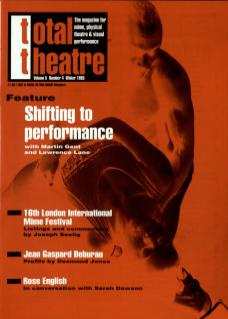Back in 1991, I was approached by Martin Burton, proprietor of Zippos Circus, billed as Europe's Number 1 Human Circus, to assist him in creating a National Circus Academy. The idea was a brilliant one: to create a training school utilising the expertise, skill and knowledge of both the new and traditional circus world and to train the apprentices on tour so that they had an instant grasp of the lifestyle. Finding funding for a new training establishment that deals with circus, which is not yet officially recognised by the Arts Council as an art form, was initially near impossible.
Zippos Academy of Circus Arts, as it came to be called, was kickstarted by a successful application to the Foundation For Sports and The Arts. Although the money provided by them was very small in comparison to the overall budget, it covered the purchase of living accommodation (in the form of a circus bunk truck) plus a lorry to pull it and basic circus equipment for the apprentices such as trapeze bars, crash mats, etc. The money to cover the training costs was met to an extent by the Arts Council (albeit at the last minute), our private sponsor Christopher Stone, BSIS, and Southern Arts. The gap in funding which enabled the project to fulfil its lifespan was bridged by a personal donation from Martin Burton.
Auditions were advertised and hopefuls arrived for two full days of sample training sessions to test strength, coordination, aptitude, skill level, et al. From these auditions apprentices were chosen and accepted for the six-month course but put on a month's trial. Living in a small space on the road is difficult enough, but training from ten in the morning until ten at night virtually seven days per week would finish off most people. We had to be sure that the apprentices would stay the distance. For the first month the Academy was based with the main circus, learning about tent erection, rigging, health and safety, plus putting together an act, ranging from ‘run-ins’ to full specialist pieces so that they could progress into the separate touring section.
Once the induction course was over, the Academy took to the road with its own tent, teaching staff, performers and crew and began a fifteen-week training tour. Spending time away from the main circus, the apprentices had the opportunity to be involved with a production in the fullest sense. They learnt to do everything from making a performance piece to putting up the tent. They had to deal with different performance environments and cope with the problems of being on tour. This was a very long fifteen weeks for them and the calls on their time were enormous. By the end of this section they had had the opportunity to perform in 180 or so professional performances. Exposure to the public is one of the best methods of training, so when the academy rejoined the main show each apprentice was well on the way to producing their own specialist circus acts.
Work now began on the End of Term Showcase and over the next few weeks, working virtually around the clock, the Showcase was choreographed featuring acts from all of the apprentices. This was performed to an eager audience in late October and was followed by a graduation ceremony with guest star Terry Major!
Throughout the six months physical training the apprentices had also been agonising over the RSA Diploma course which offered underpinning knowledge in a range of topics from Health and Safety to Business Management. Each module examined a different topic and required the apprentice to complete a series of related tasks and prove that they had done so, which caused much mirth as photographs of the weirdest events had to be taken and stuck into scrap books. By graduation, each apprentice could book a tour, erect, light and rig a tent, handle box office duties, and perform in the show with solo and group slots. Added to which the RSA Diploma, the first accreditation for circus training in Britain, could prove this to a future employer. The RSA has paved the way for the much publicised National Vocational Qualification (NVQs) which will come in next year for the performing arts and we plan to pilot the standards during next year's course.
I am pleased with our progress over this first year and we now have a solid base for future years. The apprentices have graduated with honours and the work they have produced amazed even the old circus hands in the audience. We have proved that there is a need for quality circus training which equips its trainees to gain employment straight from graduation and created a facility to provide this in Britain. All we need now is the funding...
Verena Cornwall also runs her own company, Combined Arts Management. She is author of the report ‘Creating a Blueprint for Circus in the 90s’.

